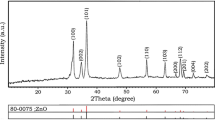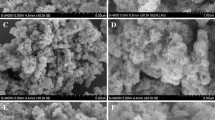Abstract
ZnO nanostructures were synthesized by solvothermal (STT), solution combustion (SCT), and template synthesis (TS) techniques, showing the formation of rod-like, dot-like, and wire-like morphology. Pure-phase wurtzite structure was observed for STT and SCT samples, and mixed-phase wurtzite structure for the TS sample. Strong excitonic peaks appeared for STT and TS samples, whereas the excitonic peak tended to shift for the SCT sample. Dye-sensitized solar cell device structures using natural anthocyanin dye were fabricated and their I–V characteristics studied. The ZnO nanowire-based device showed the maximum open-circuit voltage (Voc) and short-circuit current density (Isc) in comparison with the rod-like and flake-like ZnO nanostructures. The photoconversion efficiency (PCE) was found to be 3.2%, 4.4%, and 5.4% for the rod-, dot-, and wire-like morphology, respectively. The enhancement in the PCE can be attributed to increased charge collection at the interface of the ZnO photoanode and electrolyte layer.








Similar content being viewed by others
References
B. O’Regan and M. Grätzel, Nature 353, 737 (1991).
B. Li, L. Wang, B. Kang, P. Wang, and Y. Qiu, Sol. Energy Mater. Sol. Cells 90, 549 (2006).
L. Andrade, H.A. Ribeiro, and A. Mendes, Encycl. Inorg. Bioinorg. Chem. 1 (2011).
K.R. Millington, Encycl. Electrochem. Power Sources 35, 10 (2009).
J. Gong, J. Liang, and K. Sumathy, Renew. Sustain. Energy Rev. 16, 5848 (2012).
S. Mathew, A. Yella, P. Gao, R. Humphry-Baker, B.F. Curchod, N. Ashari-Astani, I. Tavernelli, U. Rothlisberger, M.K. Nazeeruddin, and M. Grätzel, Nat. Chem. 6, 242 (2014).
V. Sugathan, E. John, and K. Sudhakar, Renew. Sustain. Energy Rev. 52, 54 (2015).
S. Mahalingam and H. Abdullah, Renew. Sustain. Energy Rev. 63, 245 (2016).
S. Suhaimi, M.M. Shahimin, Z.A. Alahmed, J. Chysky, and A.H. Reshak, Int. J. Electrochem. Sci. 10, 2859 (2015).
C.D. Grant, A.M. Schwartzberg, G.P. Smestad, J. Kowalik, L.M. Tolbert, and J.Z. Zhang, J. Electroanal. Chem. 522, 40 (2002).
F.O. Lenzmann and J.M. Kroon, Adv. Optoelectron. 65073, 10 (2007).
M.K. Nazeeruddin, F. de Angelis, and S. Fantacci, et al., J. Am. Chem. Soc. 127, 16835 (2005).
M. Gratzel, J. Photochem. Photobiol. A Chem. 164, 3 (2004).
K. Hara, T. Sato, and R. Katohetal, J. Phys. Chem. B 107, 597 (2003).
N.A. Andersen and T. Lian, Annu. Rev. Phys. Chem. 56, 491 (2005).
J.-H. Yum, E. Baranoff, S. Wenger, M.K. Nazeeruddin, and M. Gratzel, Energy Environ. Sci. 4, 842 (2011).
C. Sima, C. Grigoriu, and S. Antohe, Thin Solid Films 519, 595 (2010).
T.N. Murakami, Y. Kijitori, N. Kawashima, and T. Miyasaka, J. Photochem. Photobiol. A Chem. 164, 187 (2004).
S. Shalini, R. Balasundara Prabhu, S. Prasanna, T.K. Mallick, and S. Senthilarasu, Renew. Sustain. Energy Rev. 51, 1306 (2015).
R. Prabhakar, K. Woon-Ki, and Y. Yeon-Tae, ACS Appl. Mater. Interfaces 5, 3026 (2013).
M. Amdad Ali, M. Rahman Idris, and M. Emran Quayum, J. Nanostruct. Chem. 3, 1 (2013).
N. Kumar, G.D. Varma, R. Nath, and A.K. Srivastava, Appl. Phys. A 104, 1169 (2011).
J. Prakash Maran, V. Sivakumar, K. Thirugnanasambandham, and R. Sridhar, J. Food Sci. Technol. 52, 3617 (2015).
T. Ghoshal, S. Biswas, M. Paul, and S.K. De, J. Nanosci. Nanotechnol. 9, 5973 (2009).
D. Gao, Z. Shi, Y. Xu, J. Zhang, G. Yang, J. Zhang, Z. Wang, and D. Xue, Nanoscale Res. Lett. 5, 1289 (2010).
S. Chakraborty, A.K. Kole, and P. Kumbhakar, Mater. Lett. 67, 362 (2012).
P.S. Xu, Y.M. Sun, C.S. Shi, F.Q. Xu, and H.B. Pan, Nucl. Instrum. Methods Phys. Res. B 199, 286 (2003).
S. Getie, A. Belay, A.R. Chandra Reddy, and Z. Belay, J. Nanomed. Nanotechnol. S8, 04 (2017).
S. Suwanboon, P. Amornpitoksuk, P. Bangrak, A. Sukolrat, and N. Muensit, J. Ceram. Process. Res. 11, 547 (2010).
N. Morales-Flores, R. Galeazzi, E. Rosendo, T. Díaz, S. Velumani, and U. Pal, Adv. Nano Res. 1, 59 (2013).
R. Khokhra, B. Bharti, H.-N. Lee, and R. Kumar, Sci. Rep. 7, 1 (2017).
Y. Gu, I.L. Kuskovsky, M. Yin, S. O’Brien, and G.F. Neumark, Appl. Phys. Lett. 85, 3833 (2004).
U. Manzoor, M. Islam, L. Tabassam, and S. Ur Rahman, Phys. E 41, 1669 (2009).
T. Movlarooy, Mater. Res. Express 5, 035032 (2018).
T. Marimuthu, N. Anandhan, and R. Thangamuthu, Appl. Surf. Sci. 428, 385 (2018).
E.M. Elsayed, A.E. Shalan, and M.M. Rashad, J. Mater. Sci. Mater. Electron. 25, 3412 (2014).
Acknowledgements
This research was supported by the Basic Science Research Program through the National Research Foundation of Korea (NRF) funded by the Ministry of Education, Science, and Technology (2018R1D1A1B07051095, 2018R1D1A1B07050237, and 2016R1A6A1A03012877).
Author information
Authors and Affiliations
Corresponding author
Additional information
Publisher's Note
Springer Nature remains neutral with regard to jurisdictional claims in published maps and institutional affiliations.
Rights and permissions
About this article
Cite this article
Singh, H., Kumar, V., Raj, D. et al. Influence of Synthesis-Dependent Structural Morphology on Performance of Natural Dye-Sensitized ZnO Solar Cells. JOM 71, 1477–1484 (2019). https://doi.org/10.1007/s11837-019-03372-4
Received:
Accepted:
Published:
Issue Date:
DOI: https://doi.org/10.1007/s11837-019-03372-4




